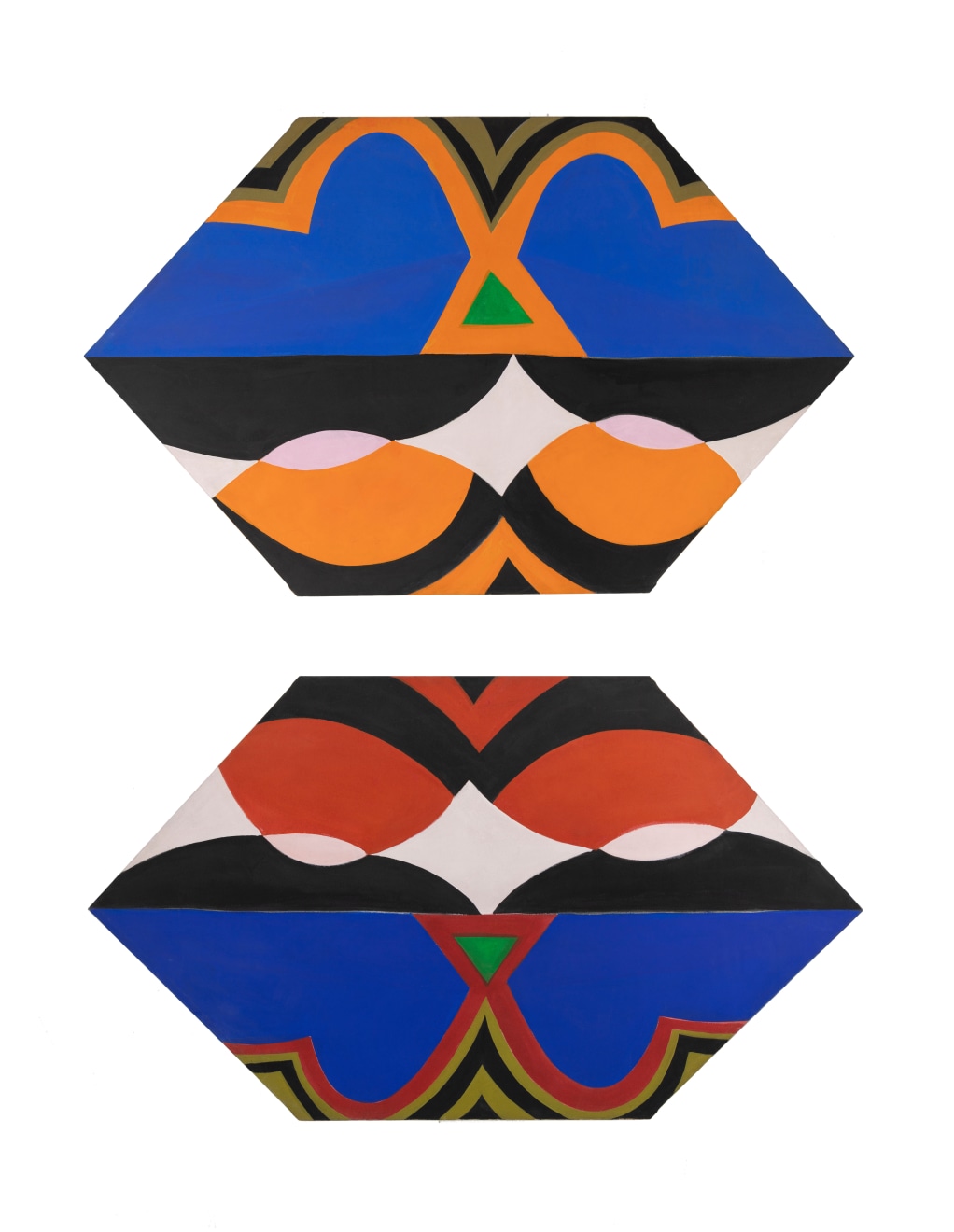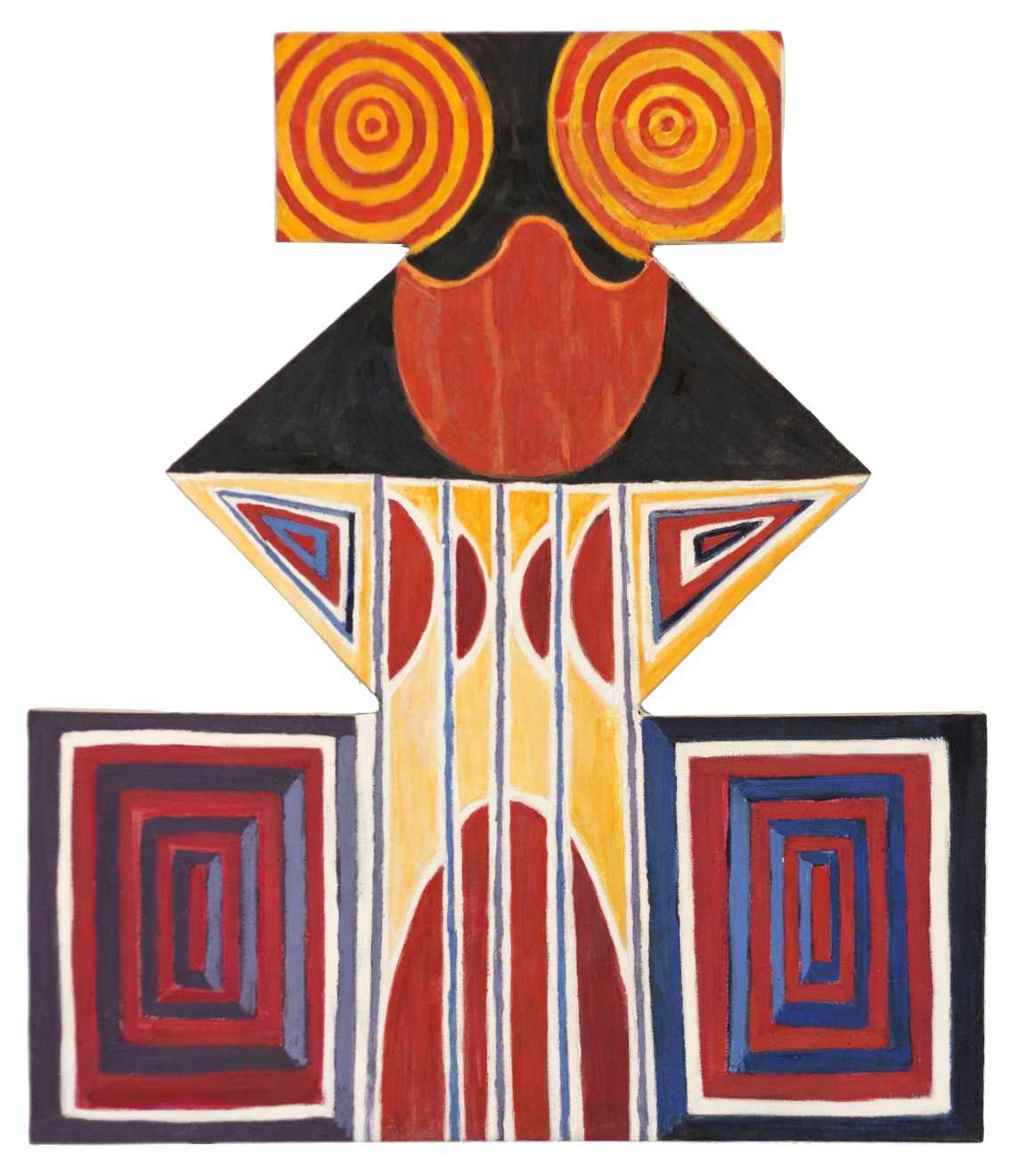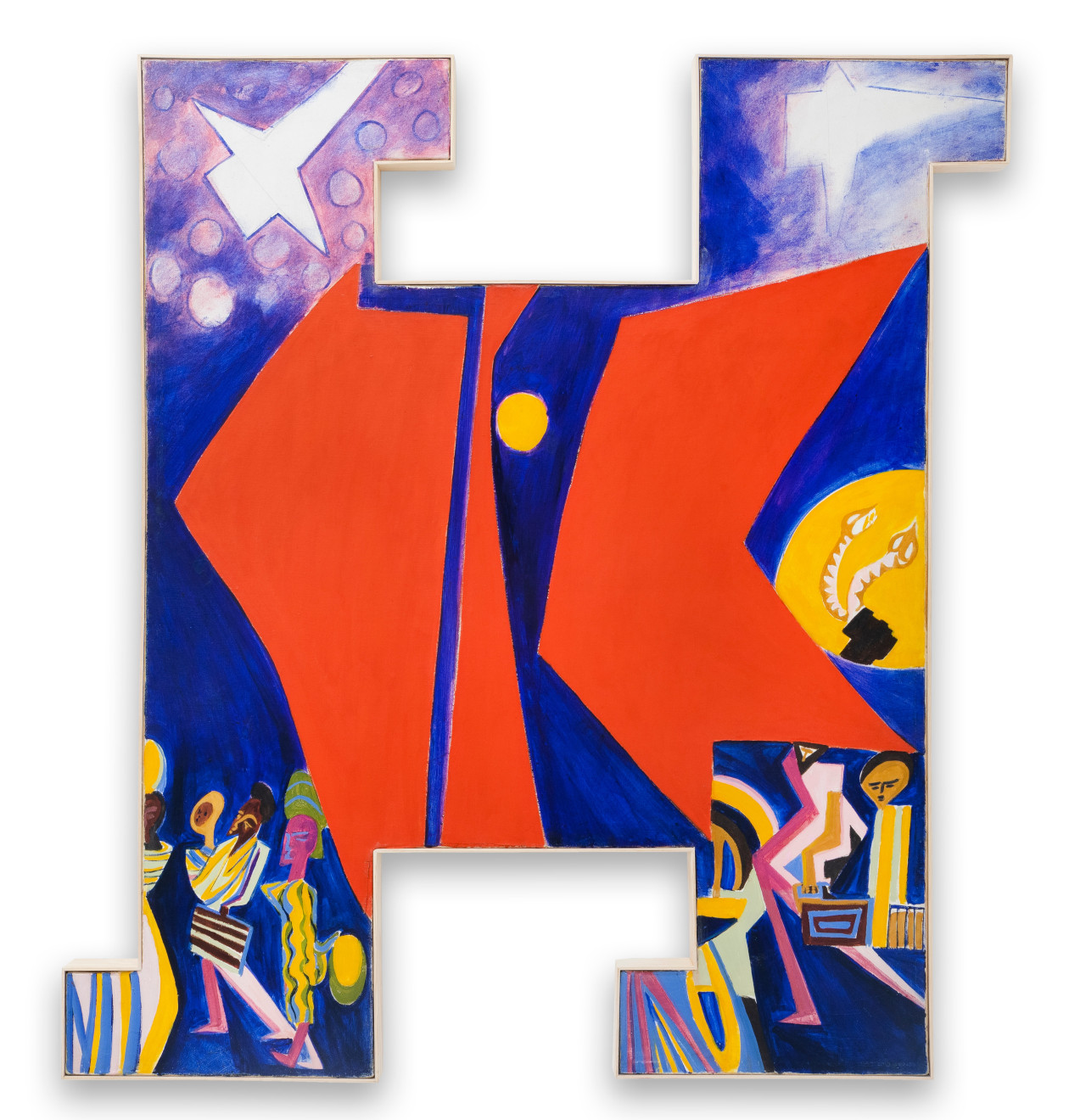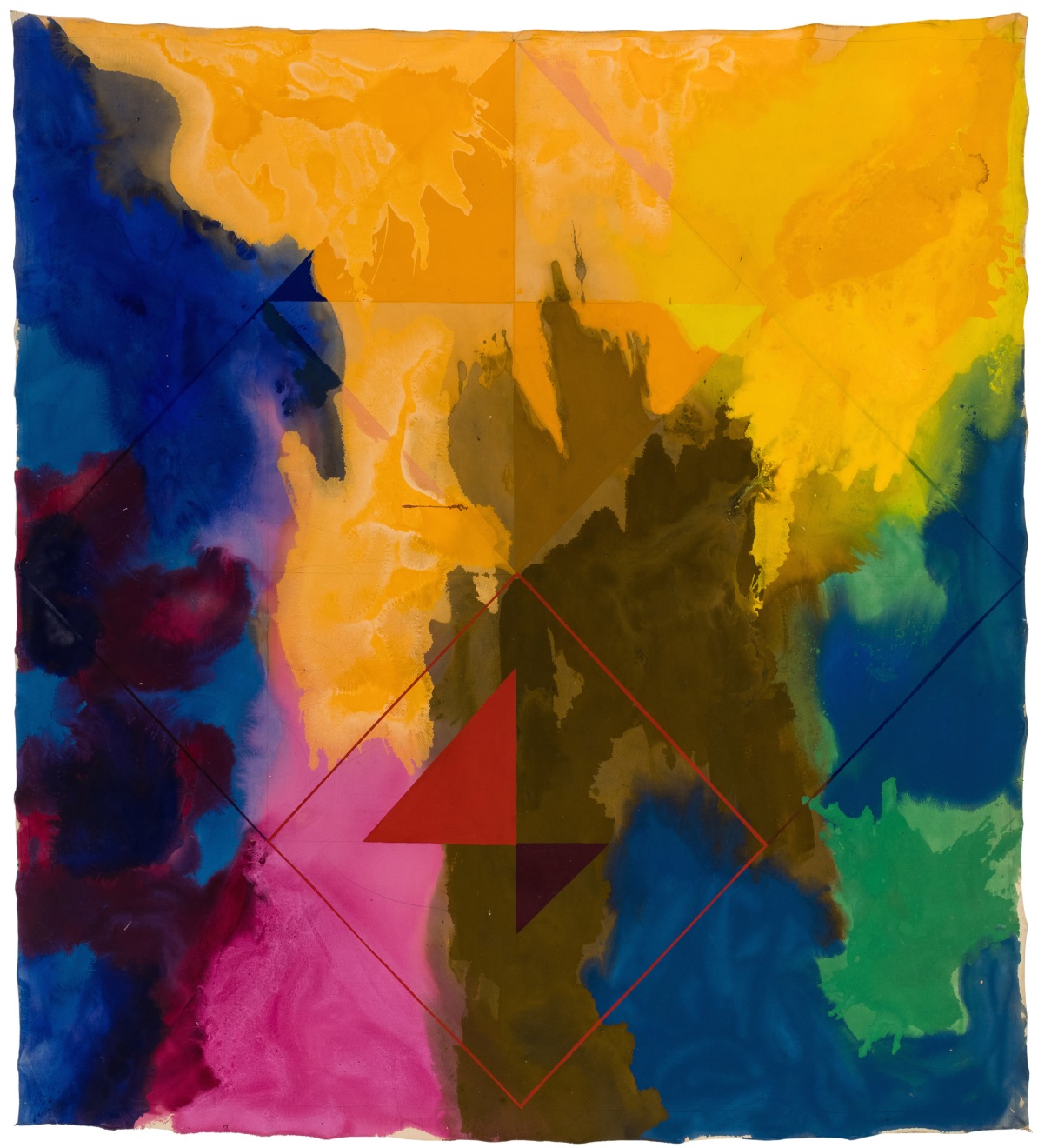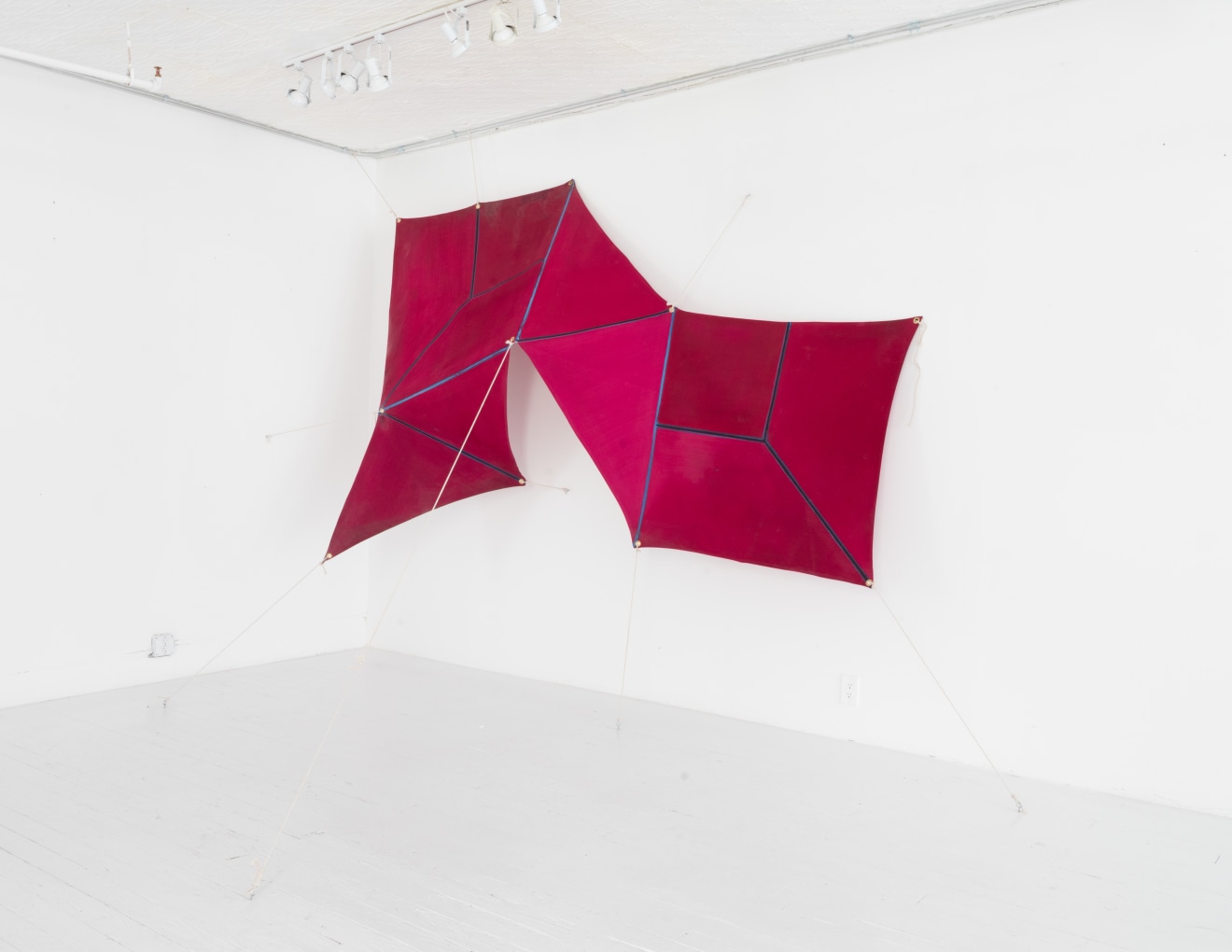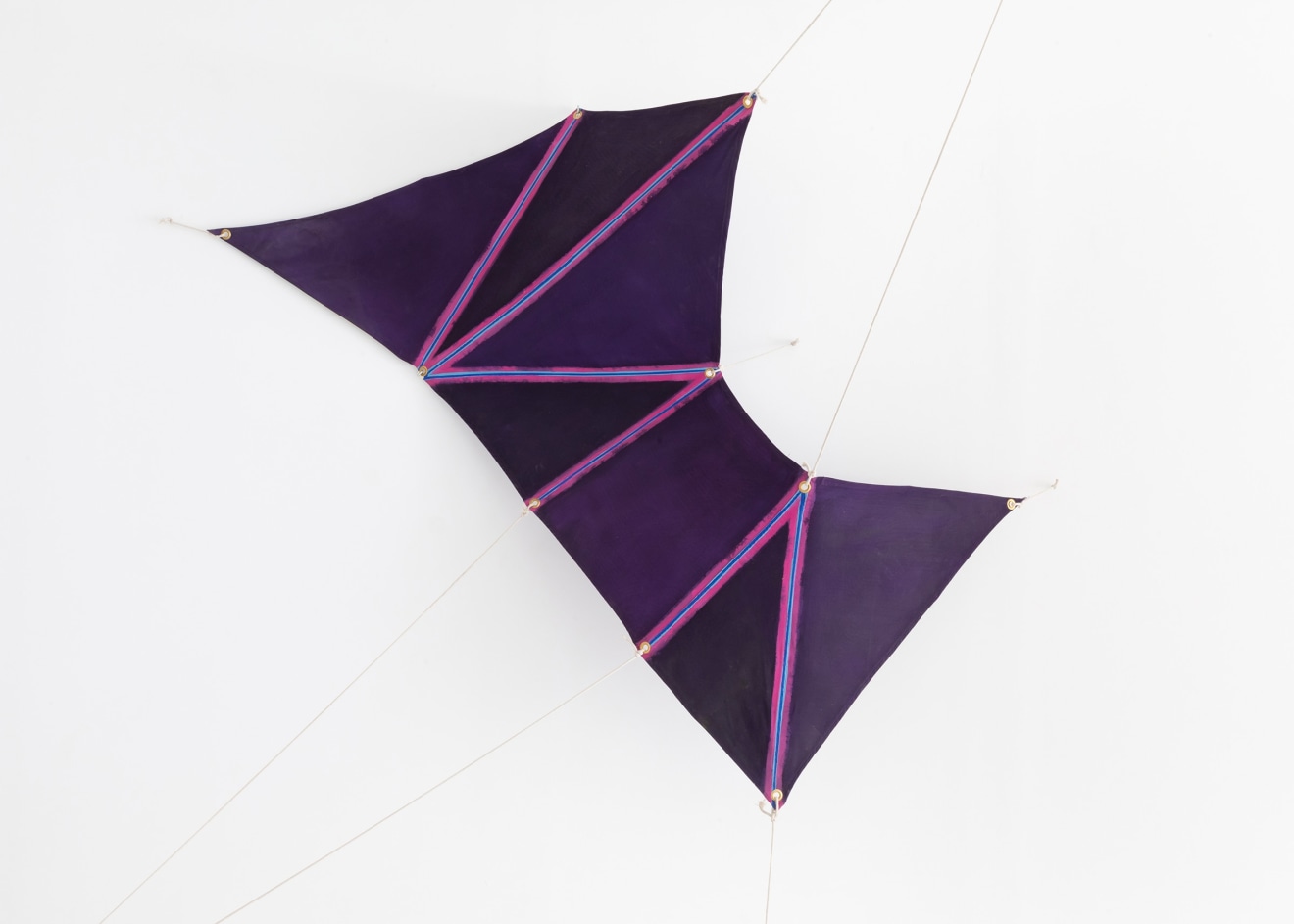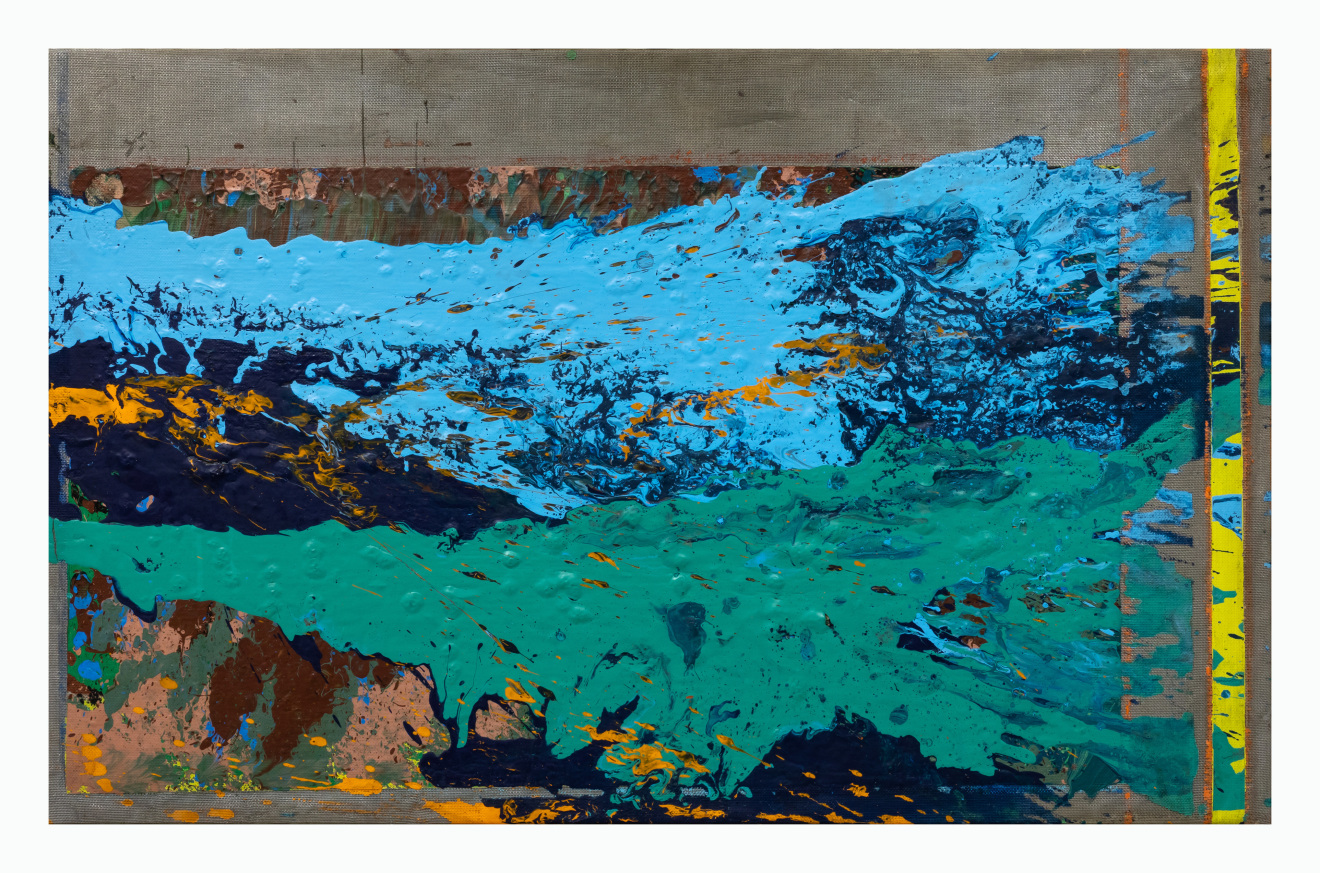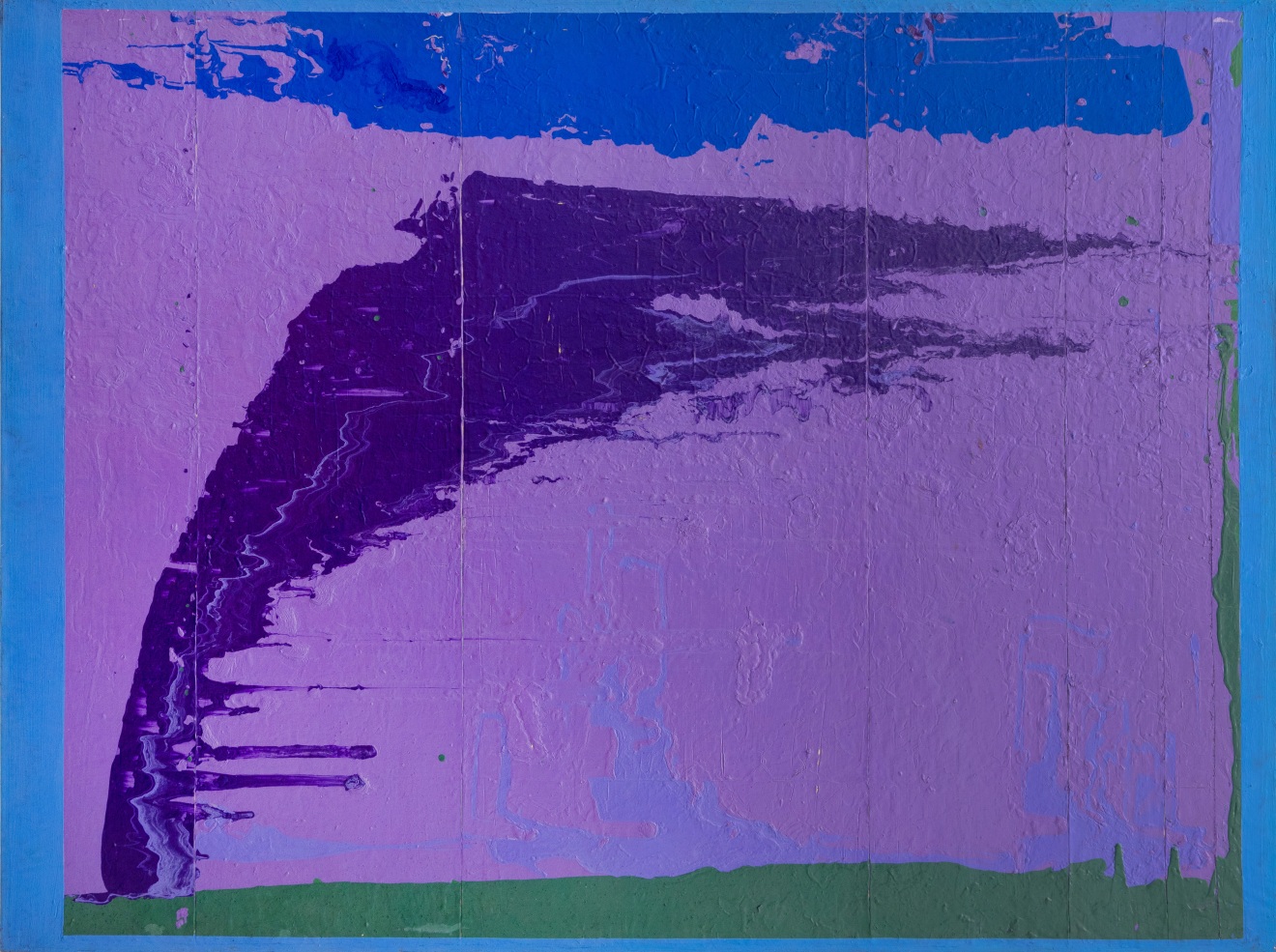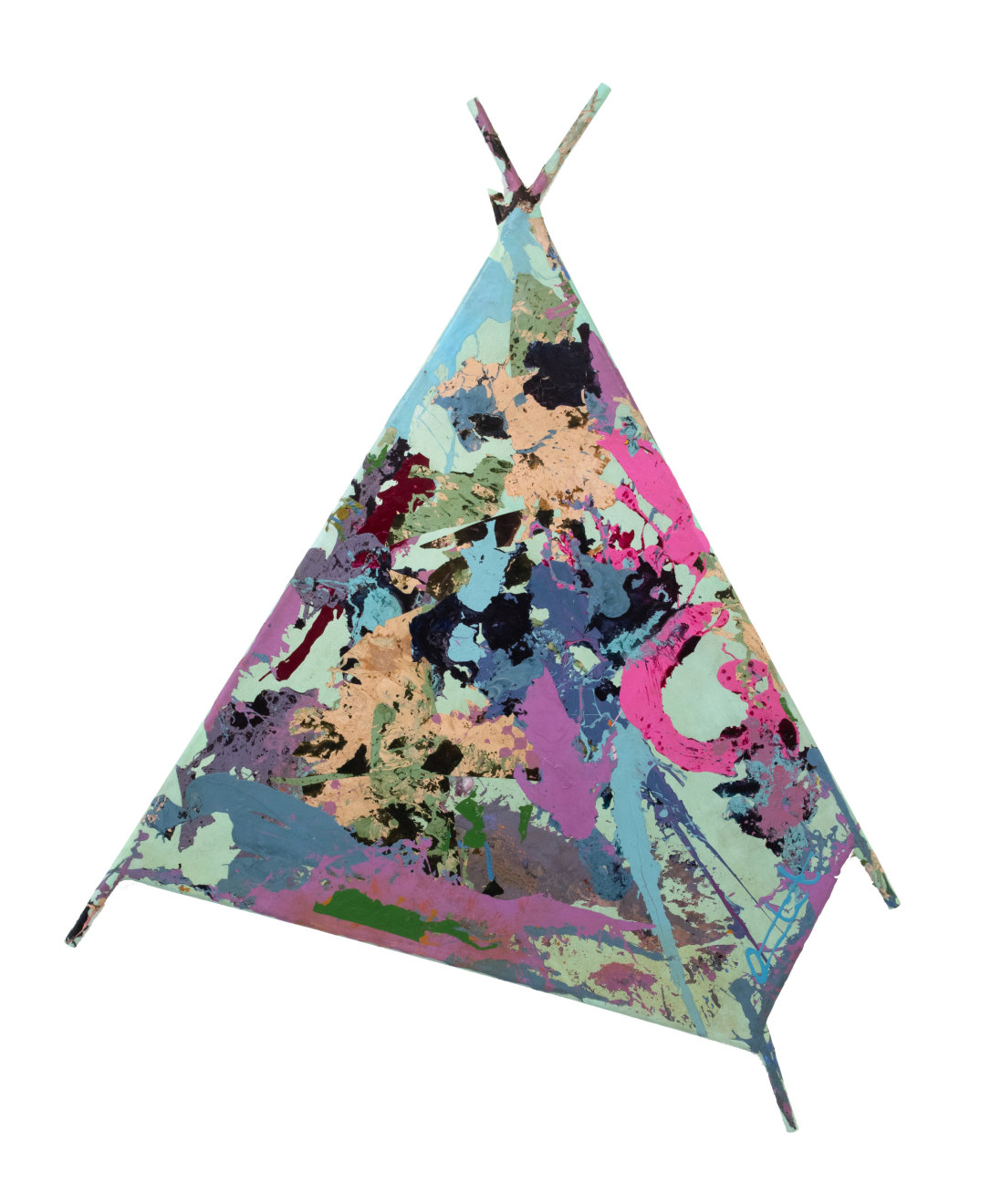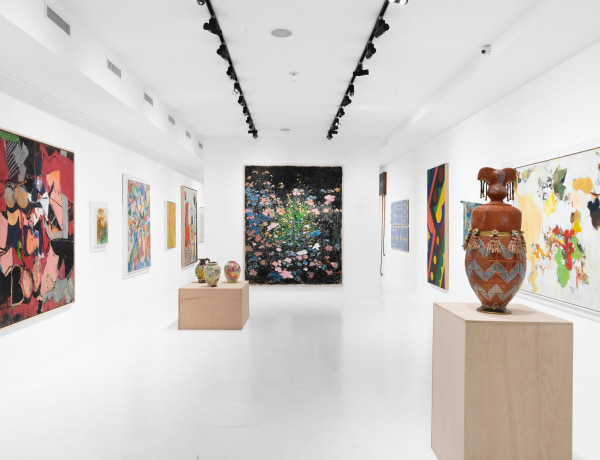
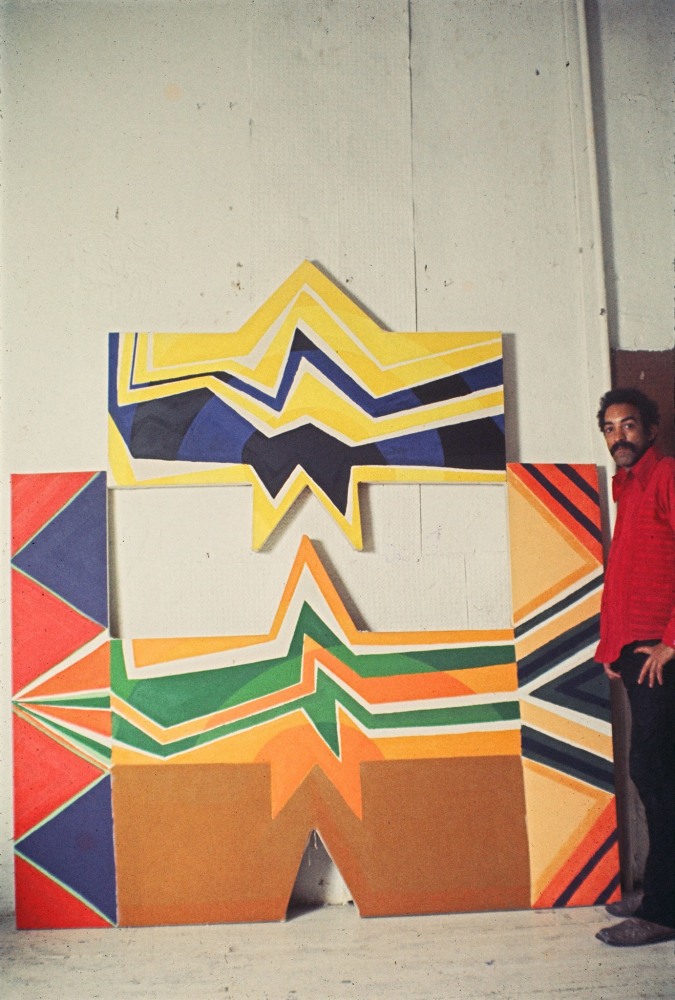
Joe Overstreet pictured next to his painting North Star (1968), c. 1968.
B. CONEHATTA, MISSISSIPPI, 1933
D. NEW YORK, NY 2019
Joe Overstreet was an artist and activist who pushed the boundaries of painting through decades of experiments in abstraction. He began his career in the Bay Area as a fixture of the Beat scene, living in the North Beach section of San Francisco. After moving to New York, he and his partner Corrine Jennings established Kenkeleba House, a gallery that has presented innumerable exhibitions of work by artists of color and women. As part of a generation of Black artists who fought for their visibility in an exclusionary art world, Overstreet was committed to creating paintings that stand alone on formal merit – independent of his identity – and taking an organizer’s role in providing exhibition opportunities to his peers. Overstreet’s work of the late 1950s to the mid 1960s assimilates his interests in Abstract Expressionism, Jazz, and African-American history. Many of his paintings are direct responses to the Civil Rights movement, racism, and the history of lynching.
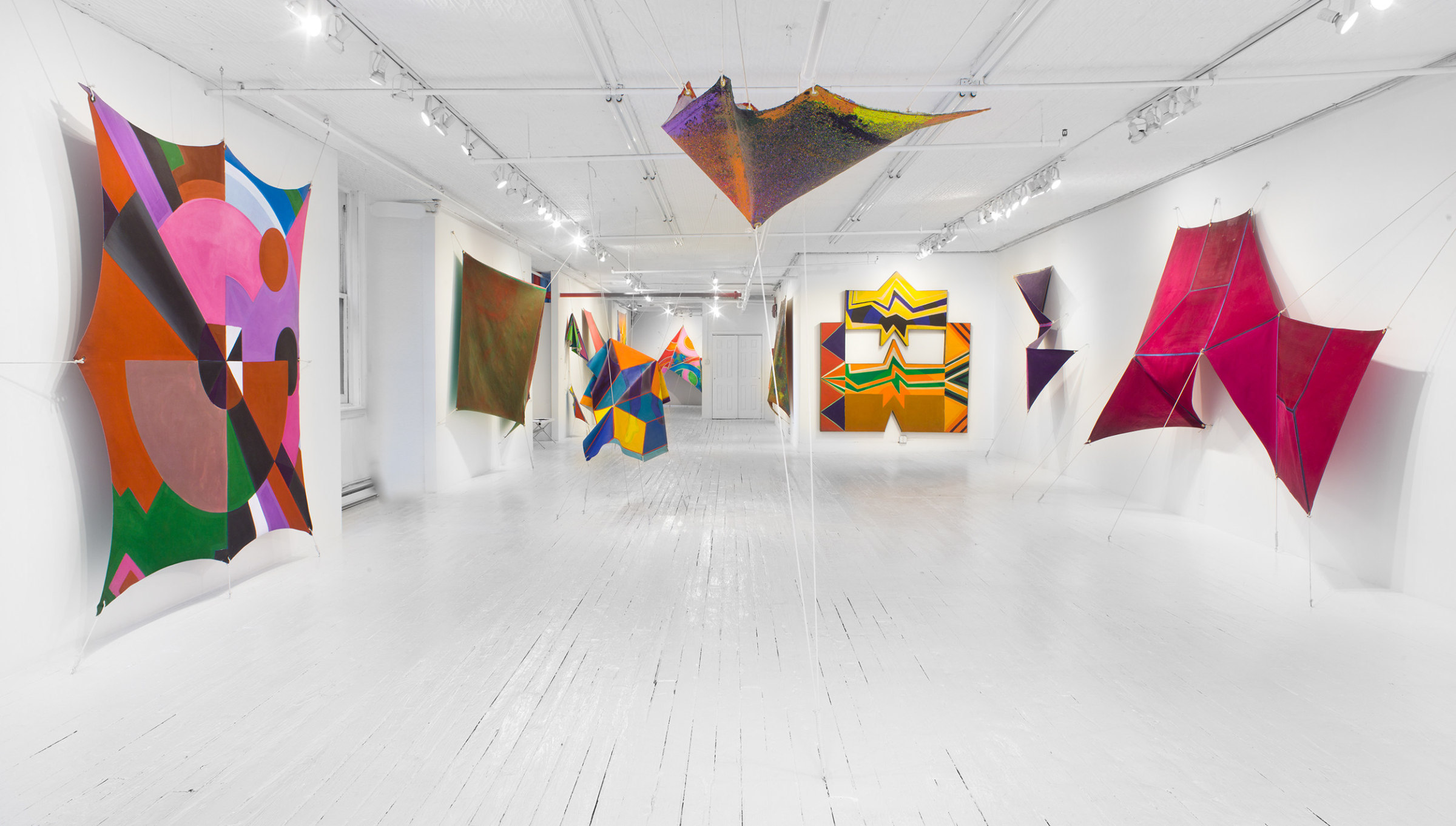
Installation view of Joe Overstreet, Innovation of Flight: Paintings 1967–1972, Eric Firestone Gallery, New York, 2018.
By 1967, Overstreet started working with shaped canvases. He used wooden dowels shaped with a jigsaw and hand tools to make intricate stretchers, painting figures in patterns drawn from Aztec, Benin, and Egyptian cultures. Overstreet said, “I was beginning to look at my art in a different light, not as protest, but as a statement about people...By 1970 I had broken free from notions that paintings had to be on the wall in rectangular shapes.” Overstreet was a major innovator in terms of taking the canvas off the wall. In his “Flight Pattern” series of the early 1970s, painted, unstretched canvases are tethered with ropes to the ceiling, walls, and floor. Many assume mandala-like imagery. Overstreet states, “I began to make paintings that were tent-like. I was making nomadic art, and I could roll it up and travel...We had survived with our art by rolling it up and moving it all over... I felt like a nomad myself, with all the insensitivity in America.”
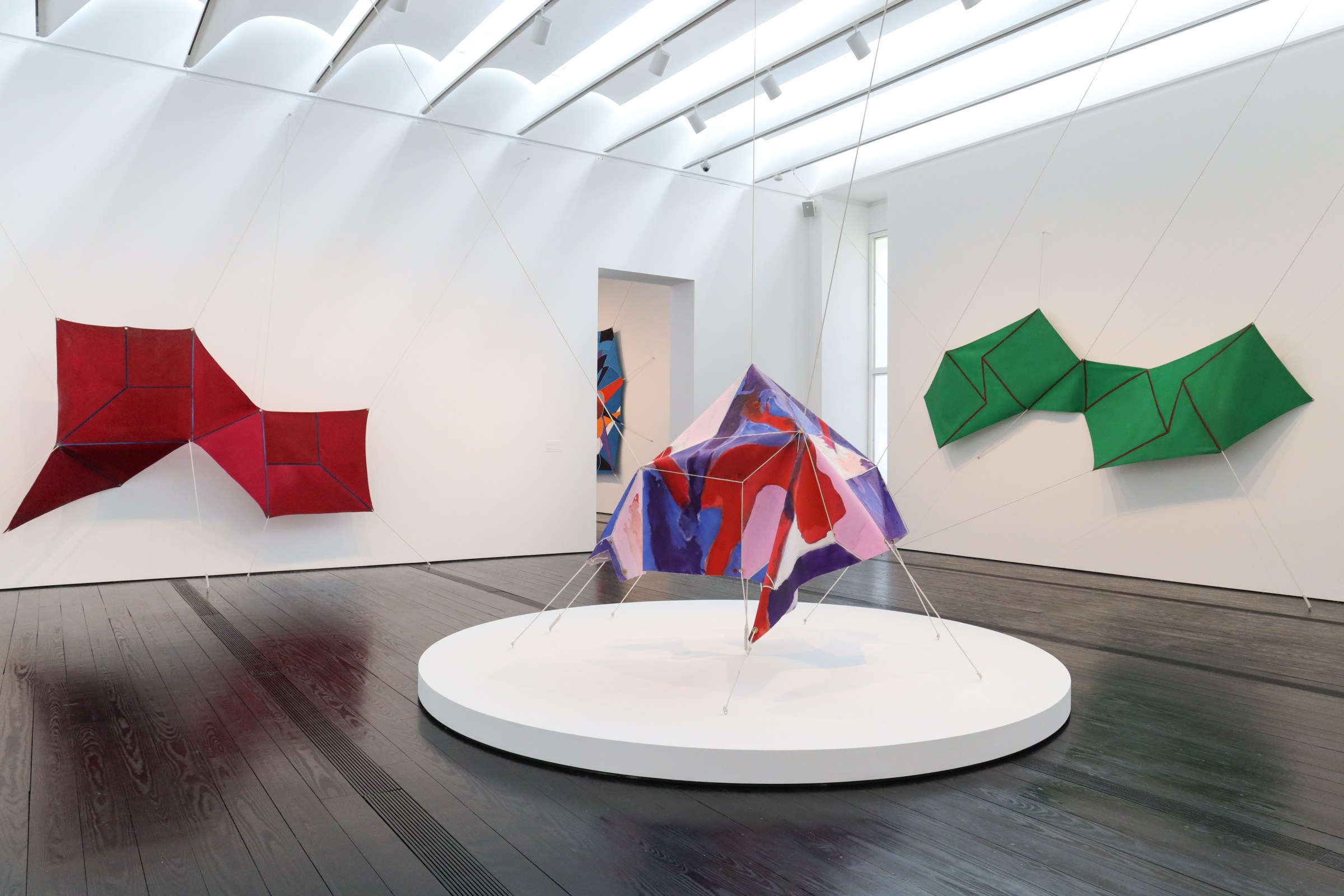
Installation view: Joe Overstreet: Taking Flight, The Menil Collection, Houston, 2025. Photo: Sarah Hobson.
For decades, Overstreet was a relentless experimenter, investigating the spatial and textural possibilities of painting as well as complex cultural histories. Joe Overstreet: Taking Flight, a major survey curated by Natalie Dupêcher of the Menil Collection, Houston, TX, closed in July and is traveling to the Mississippi Museum of Art, Jackson, MS in October of 2025. Overstreet was featured in the 2021-22 traveling exhibition The Dirty South, curated by Valerie Cassel Oliver for the Virginia Museum of Fine Art, Richmond, VA. The work on view was recently acquired for the permanent collection of the VMFA. Overstreet was also featured in Soul of a Nation: Art in the Age of Black Power (2017) at Tate Britain, London, England, which travelled to the Brooklyn Museum, NY and other U.S. venues. Most recently Overstreet was included in the 2024 exhibition Edges of Ailey at the Whitney Museum of American Art.
Overstreet’s work can also be found in the collections of the The Berkeley Art Museum and Pacific Film Archive, Berkeley, CA; The Brooklyn Museum, NY; Art Bridges, Crystal Bridges, Bentonville, AR; the Museum of Fine Arts Boston, MA; Everson Museum of Art, Syracuse, NY; the Joyner/Giuffrida Collection of Abstract Art; Mississippi Museum of Art, Jackson, MS; Rose Art Museum of Brandeis University, Waltham, MA; the Rennie Collection, Vancouver, Canada; and the Menil Collection, Houston, TX.
Joe Overstreet: Taking Flight is the first major museum exhibition in thirty years devoted to the work of this pioneering abstract painter. Renowned for his innovative approach to non-representational painting, American artist Joe Overstreet (1933–2019) consistently sought to intertwine abstraction and social politics. This presentation will include his landmark Flight Pattern series of radially suspended paintings from the early 1970s, as well as related bodies of work from the 1960s and 1990s. Overstreet made a significant contribution to postwar art, positioning abstraction as an expansive tool for exploring the idea of freedom and the Black experience in the United States.
An exhibition devoted to the African-American abstract painter highlights his energetic forms, tense lines and subtle political commentary.
Until his final years, Joe Overstreet (1933–2019) worked at Kenkeleba House, an East Village arts organization providing a gallery and studios, which he founded in 1974 with his future wife, curator and historian Corrine Jennings, and writer Samuel C. Floyd. I was fortunate to once visit Kenkeleba House with artist David Reed and witness both Overstreet’s studio and the extensive and impressive archive of work by Black American artists collected and housed at the institution. Knowing this background, it was thrilling to encounter the current exhibition, Taking Flight, at the Menil Collection and see Overstreet’s works so dynamically and meticulously presented. Three major series of paintings sequentially unfold across several generously sized gallery spaces. The height of the ceilings also allows for the placement of works in relation to each other in ways that emphasize Overstreet’s pioneering use of space for exhibiting visual art. Color, pattern, and three-dimensionality meld together effortlessly and inventively.
Review of Joe Overstreet: Taking Flight, at the Menil Collection, Houston, January 24 – July 13, 2025.
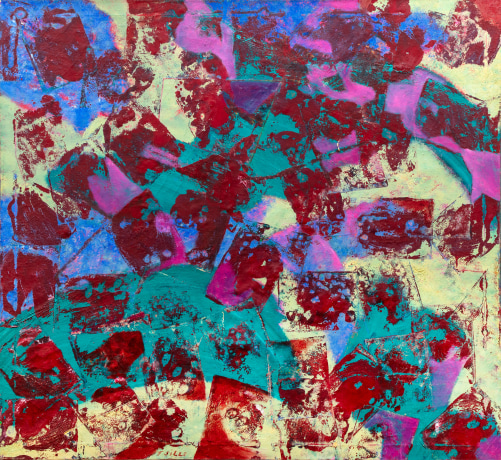
April 4, 1968, was a day of mourning for nearly every American, with an outpouring of grief following the assassination of Martin Luther King Jr. by a white supremacist. April 5, 1968, was the day painter Joe Overstreet began work on Justice, Faith, Hope, and Peace (1968), a four-panel shaped canvas that encapsulated the mood of the moment.
Two diamond-shaped panels, with targetlike forms rendered in raucous shades of red and orange, lie at the center of this painting; they are bookended by a pair of rectangular panels painted with symbols that recall blasts, their pointed cerulean forms blown apart by jagged shapes. Despite its cheerful colors, the painting suggests violence and upheaval.
Justice, Faith, Hope, and Peace is aptly placed at the start of a terrific exhibition of Overstreet’s work at the Menil Collection in Houston. It is an overdue survey for the late artist, who has gone overlooked by major museums in this country for far too long. The 30 or so paintings assembled here are variations on a theme: They propose abstraction as a path toward liberation.
Edges of Ailey is the first large-scale museum exhibition to celebrate the life, dances, influences, and enduring legacy of visionary artist and choreographer Alvin Ailey (b. 1931, Rogers, Texas; d. 1989, New York, New York).
The power of an artwork is often amplified when in dialogue or debate with another. It Takes 2: Unexpected Pairings explores the resonances and dissonances that arise when unrelated objects are set side by side.
What Has Been and What Could Be: The BAMPFA Collection inaugurates a year-long presentation of the BAMPFA collection, bringing a contemporary perspective to the museum’s global art holdings.
After thirteen years and twenty-one exhibitions, rennie museum announces our final presentation in the historic Wing Sang building. The exhibition opens August 13 and concludes November 12, 2022.
Featuring fifty-one artworks by thirty-seven prominent artists from A(bdessemed) to Y(iadom-Boakye), the farewell exhibition breaks the museum’s self-imposed rule of not titling its shows. 51 @ 51 references the number of artworks in the exhibit as well as the address of the museum—51 East Pender Street.
Unbound brings together a multigenerational group of artists whose work takes an inventive and experimental approach to abstraction.
The MFAH presents the U.S. tour of Afro-Atlantic Histories, an unprecedented exhibition that explores the history and legacy of the transatlantic slave trade. The exhibition comprises more than 130 works of art and documents made in Africa, the Americas, the Caribbean, and Europe across 500 years, from the 17th century to the 21st century.
Afro-Atlantic Histories dynamically juxtaposes works by artists from 24 countries, representing evolving perspectives across time and geography through major paintings, drawings, prints, sculptures, photographs, time-based media art, and ephemera. The range extends from historical paintings by Jean-Baptiste Debret, Frans Post, and Dirk Valkenburg to contemporary art by Melvin Edwards, Ibrahim Mahama, and Kara Walker.
The exhibition premiered at the Museu de Arte de São Paulo (MASP) in Brazil, and the U.S. tour builds on the presentation through the overarching theme of histórias—a Portuguese term that can encompass both fictional and non-fictional narratives of cultural, economic, personal, or political character. The term is plural, diverse, and inclusive, offering viewpoints that have been marginalized or forgotten. Afro-Atlantic Histories unfolds through six thematic sections that explore the varied histories of the diaspora.
Joe Overstreet’s 1972 unstretched, untitled canvas unfurls from the wall in a similar fashion to Eric N. Mack’s “Pelle Pelle” (2017), which is made with a microfiber blanket, polyester fabric and silk curtains tacked to the wall. Paintings and assemblages from the ’70s based on the grid by Joan Snyder, Howardena Pindell, Sean Scully and Al Loving sit comfortably next to more recent riffs on geometry by Sadie Benning, Matt Connors and Dona Nelson.
The Dirty South: Contemporary Art, Material Culture, and the Sonic Impulse, organized by the Virginia Museum of Fine Arts, investigates the aesthetic impulses of early 20th-century Black culture that have proved ubiquitous to the southern region of the United States. The exhibition chronicles the pervasive sonic and visual parallels that have served to shape the contemporary landscape, and looks deeply into the frameworks of landscape, religion, and the Black body—deep meditative repositories of thought and expression. Within the visual expression, assemblage, collage, appropriation, and sonic transference are explored as deeply connected to music tradition. The visual expression of the African American South along with the Black sonic culture are overlooked tributaries to the development of art in the United States and serve as interlocutors of American modernism. This exhibition looks to the contributions of artists, academically trained as well as those who were relegated to the margins as “outsiders,” to uncover the foundational aesthetics that gave rise to the shaping of our contemporary expression. The exhibition travels to the Contemporary Art Museum, Houston, Oct. 23, 2021-Feb. 6, 2022; Crystal Bridges Museum of American Art, Bentonville, Ark., March 12-July 25, 2022; and the Museum of Contemporary Art, Denver, Sept. 2022-Feb.
My paintings don’t let the onlooker glance over them, but rather take them deeply into them and let them out—many times by different routes,” artist Joe Overstreet once said, describing viewing experiences that can be variously harrowing and exhilarating. “These trips are taken sometimes subtly and sometimes suddenly.”
Joe Overstreet, an artist and activist who in the 1960s took abstract painting into the sculptural dimension and later created a home in New York for art- ists who had been ignored by the mainstream, died on June 4 in Manhattan. He was 85.
Soul of a Nation: Art in the Age of Black Power shines a bright light on the vital contribution of Black artists to an important period in American history and art. Featuring the work of 60 artists and including vibrant paintings, powerful sculptures, street photography, murals, and more, this landmark exhibition is a rare opportunity to see era-defining artworks that changed the face of art in America.
The internationally acclaimed exhibition Soul of a Nation: Art in the Age of Black Power will travel to San Francisco this fall. Celebrating the works that African American artists created during two pivotal decades in American history (1963–1983), the exhibition—organized by Tate Modern, London—examines the very purpose of art and the role of artists in society.
Last year the Armory Show weathered a crisis when Pier 92 over the Hudson River was condemned shortly before the art fair opened, precipitating a last-minute reshuffling of booths and the shutting down of a satellite display.
When the acclaimed touring exhibition Solidary & Solitary reaches the BMA, it will significantly expand to more than 80 paintings, sculptures, and mixed media works and take on a new title, Generations: A History of Black Abstract Art. The exhibition offers a sweeping new perspective on the contributions black artists have made to the evolution of visual art from the 1940s to the present moment. Artists featured include pioneers of postwar abstraction once overlooked by history, such as Norman Lewis, Alma W. Thomas, and Jack Whitten, as well as artists from a younger generation such as Kevin Beasley, Mark Bradford, Martin Puryear, Lorna Simpson, and many others.
Soul of a Nation: Art in the Age of Black Power shines a bright light on the vital contribution of Black artists made over two revolutionary decades in American history, beginning in 1963 at the height of the civil rights movement. The exhibition examines the influences, from the civil rights and Black Power movements to Minimalism and developments in abstraction, on artists such as Romare Bearden, Barkley Hendricks, Noah Purifoy, Martin Puryear, Faith Ringgold, Betye Saar, Alma Thomas, Charles White, and William T. Williams.
Rarely seen works and recent additions to the museum's permanent collection.
Taking inspiration from Mia’s recent acquisition of Frank Bowling’s map painting False Start(1970), “Mapping Black Identities” challenges the notion of Black identity as monolithic. Championing the diverse experiences of artists from America, Africa, and the diaspora, this exhibition seeks to amplify underrepresented voices and create connections around the concept of Blackness in contemporary art across time and place.
Soul of a Nation: Art in the Age of Black Power shines light on a broad spectrum of Black artistic practice from 1963 to 1983, one of the most politically, socially, and aesthetically revolutionary periods in American history. Black artists across the country worked in communities, in collectives, and individually to create a range of art responsive to the moment—including figurative and abstract painting, prints, and photography; assemblage and sculpture; and performance.
Joseph Overstreet is the 2018 recipient of the Governor’s Award for Excellence in the Arts presented by the Mississippi Arts Commission. Born in Conehatta, Mississippi, in 1933, Joe Overstreet is an artist with a record of accomplishments as an artist, arts promoter, and activist that spans 60 years.
The Menil’s growing collection, while not encyclopedic, spans the prehistoric era to the present day. Particular areas of strength include Byzantine art, West and Central African art, Surrealism, and 20th and 21st century American and European art. On September 22, 2018, the museum reopened with a year-long permanent collection initiative featuring many of the museum’s most well-known paintings and sculptures, as well as recent acquisitions and other works and promised gifts that have never before been on view in the museum. The installations will be changed several times over the course of the year-long period.
The opening installation in the African art galleries features more than 60 masks, figural sculptures and shrines, and vessels from regions of West and Central Africa. Introducing the galleries is a new presentation of paintings, works on paper, and sculptures that explore the shared histories Africa and Europe after 15th century.
Joe Overstreet’s experimental paintings from the early 1970s were made to be suspended from ceilings and tied to floors using a system of ropes and grommets. As a result, they occupy a good deal of three-dimensional space, and by design their shapes change every time they are installed, depending on how they are stretched out, draped, or crumpled. In some works, such as St. Expedite II and Untitled, both 1971, and Untitled, 1972, Overstreet has painted squares of canvas in solid colors-red, green, navy blue, deep purple-edged in contrasting stripes. Other works, such as the enormous Boxes, 1970, play with vibrant patterns of geometric abstraction but, at the same time, appear haunted by the ghosts of earlier, more figurative gestures.
“Abstraction represents self-determination and free will.” So avowed the painter James Little at a recent panel discussion held in conjunction with an exhibition of works by his fellow painter Joe Overstreet, but with the broader purpose of examining the question of “Black Artists and the Abstraction Idiom.” Little’s ringing declaration of aesthetic independence was couched in a language both explicitly political (self-determination being a right underwritten by the United Nations in its 1960 Declaration on the Granting of Independence to Colonial Countries and Peoples, which held that “All peoples have the right to…freely pursue their economic, social and cultural development”) as well as theological (though the problem of free will has earlier roots, it became urgent when Christian thinkers had to explain the origin of sin and damnation in a world created by a perfect and benevolent God). The implication of Little’s statement is that abstract art, by eschewing the forms of representation through which political and religious narratives are conveyed, enacts and exemplifies a kind of self-emancipation.
Way Bay is a sweeping exploration of the creative energies that have emerged from the San Francisco Bay Area over the past two centuries. An innovatively organized exhibition of art and film, plus poetry, performance documentation, and archival materials, Way Bay features nearly two hundred works that reveal the depth and diversity of artists’ engagement with the region’s geographic, social, and cultural landscape.
Soul of a Nation: Art in the Age of Black Power shines a bright light on the vital contribution of Black artists to an important period in American history and art. Featuring the work of 60 artists and including vibrant paintings, powerful sculptures, street photography, murals, and more, this landmark exhibition is a rare opportunity to see era-defining artworks that changed the face of art in America.
The history of postwar American abstract painting remains a work in progress. We are barely beginning to understand its sheer multiplicity in terms of the artists’ races and cultures and the works’ physical character. New information arrives in regular and humbling batches. The latest is Joe Overstreet’s stunning exhibition “Innovation of Flight, Paintings 1967-1972” at Eric Firestone. With 20 rarely seen works, it covers a brief period when Mr. Overstreet’s disavowal of painting’s usual standards and practices was unfolding rapidly in several directions, alongside efforts by Sam Gilliam, Harmony Hammond, Alan Shields and Howardena Pindell, among others.
The astonishing fecundity of the downtown New York scene during the late 1960s and early ‘70s is hardly in need of further evidence, but fortunately Joe Overstreet: Innovation of Flight provides it anyway. The exhibition, which lights up Eric Firestone Loft through May 5, includes 21 works by the 85-year-old artist and East Village denizen. Dating from a chapter of painting’s recent history that saw all manner of Post-Minimalist hybridity, Overstreet’s idiosyncratic use of paintings as sculptural material still looks fresh. There is nothing time-capsulesque about this spirited show, which includes work that would raise a buzz at the most au courant of art fairs
The show opens in 1963 at the height of the Civil Rights movement and its dreams of integration. In its wake emerged more militant calls for Black Power: a rallying cry for African American pride, autonomy and solidarity, drawing inspiration from newly independent African nations.
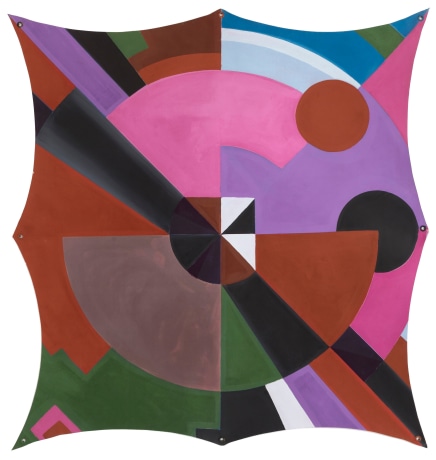
The history of postwar American abstract painting remains a work in progress. We are barely beginning to understand its sheer multiplicity in terms of the artists’ races and cultures and the works’ physical character. New information arrives in regular and humbling batches. The latest is Joe Overstreet’s stunning exhibition “Innovation of Flight, Paintings 1967-1972” at Eric Firestone. With 20 rarely seen works, it covers a brief period when Mr. Overstreet’s disavowal of painting’s usual standards and practices was unfolding rapidly in several directions, alongside efforts by Sam Gilliam, Harmony Hammond, Alan Shields and Howardena Pindell, among others.

